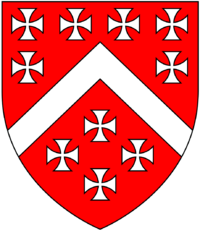Maurice Berkeley (died 1581)


Sir Maurice Berkeley (by 1514–81) of Bruton in Somerset, was an English politician who rose rapidly in the Tudor court. He came from a cadet branch of the great Berkeley family of Berkeley Castle, but in his career his initial advantage was his mother's second marriage to Sir John FitzJames, Lord Chief Justice of the King's Bench, 1526–1539, which by 1538 had brought him into the household of Thomas Cromwell, from which he passed into the royal household by 1539.[1]
He built a house on the site of Bruton Priory, a spoil of the Dissolution of the Monasteries, incorporating some of the buildings, but this was demolished in 1786. Sir Maurice's impressive Renaissance tomb, shared with his two wives, is retained in the later chancel of Church of St Mary, Bruton, Somerset. His Bruton branch of the Berkeley family produced a number of notable figures until the 18th century, including five Barons Berkeley of Stratton (extinct in 1773), and four Viscount Fitzhardinges (extinct in 1712), as well as William Berkeley, Governor of Virginia. Berkeley Square in London derives its name from this branch.
Family
He was a younger son of Richard Berkeley of Stoke, a descendant of Sir Maurice de Berkeley (1298–1347), of Uley, Gloucester, younger son of Maurice de Berkeley, 2nd Baron Berkeley (d. 1326, see Baron Berkeley). This Sir Maurice, before being killed at the Siege of Calais in 1347, had acquired Stoke Gifford in 1337, and founded the line of Berkeley of Stoke Gifford. The branch's relation to the main Berkeley line was renewed by a marriage between the elder brother of the Tudor Sir Maurice and his remote cousin the daughter of the Baron Berkeley at the time.
Career
Although he apparently never studied at the Inns of Court, his stepfather got him a job "in the office of the prothonotary of the common pleas", and by 1535 wanted to appoint him as clerk to his own circuit. But Cromwell wanted to place his own man in this role, and a deal seems to have been done. By 1537 at the latest he was a member of Thomas Cromwell's household and beginning to accumulate lands and money. He moved to the royal household a year before Cromwell's fall, and was a Gentleman of the Privy Chamber from 1539 to 1553. With his background he was able to repurpose his career in a military direction and commanded "a troop of light horse" in France in 1544 during the Italian War of 1542–46, being knighted on his return. He was appointed constable of Berkeley Castle in 1544, and chief banner bearer of England in 1545, succeeding his elder brother. He (probably) received New Year gifts from the queen in 1543 and 1544, and was left 200 marks in Henry VIII's will. He was a Protestant and kept his head down during the reign of Mary, resuming his rise under Elizabeth. He had signed the "device" settling the crown on Lady Jane Grey, but was pardoned, losing his position as banner bearer. When Wyatt's rebellion collapsed in 1554, it was Berkeley to whom Thomas Wyatt the Younger surrendered.[2]
He was a Member (MP) of the Parliament of England for Somerset in 1547, 1563 and 1572 and Bletchingley in March 1553. He was a Justice of the Peace in 1559 and appointed High Sheriff of Dorset and Somerset for 1567–68.[3]
Berkeley married twice: firstly Catherine Blount, widow of John Champernown (died c. 1541) of Modbury, Devon, and daughter of William Blount, 4th Baron Mountjoy, by his third wife, Alice Keble (died 8 June 1521), daughter of Henry Keble, Lord Mayor of London,[4][5] by whom he had 3 sons and 5 daughters, and secondly Elizabeth (in 1562), one of Queen Elizabeth's gentlewomen, the daughter of Anthony Sands of Throwley, Kent, by whom he had 2 sons and a daughter. Most of his estate passed to his son Henry, who was also an MP.[6]
Notes
- ↑ Virgoe
- ↑ Virgoe
- ↑ Virgoe
- ↑ Brown 1888, p. 152.
- ↑ Catherine Blount (c. 1518 – 25 February 1558/9), A Who’s Who of Tudor Women: B-Bl, compiled by Kathy Lynn Emerson to update and correct Wives and Daughters: The Women of Sixteenth-Century England (1984) Retrieved 6 July 2013.
- ↑ Virgoe
References
- Brown, James Roberts (1888). "Jno. and Wm. Browne, Sheriffs and Lord Mayors of London". Notes and Queries. 7th. London: John C. Francis. V: 151–3. Retrieved 5 July 2013.
- Carley, James P. (2004). "Blount, William, fourth Baron Mountjoy (c. 1478–1534)". Oxford Dictionary of National Biography (online ed.). Oxford University Press. doi:10.1093/ref:odnb/2702. (Subscription or UK public library membership required.)
- Virgoe, Roger, title=BERKELEY, Sir Maurice I (bef. 1514–81), of Bruton, Som., History of Parliament Online, accessed 22 November 2015